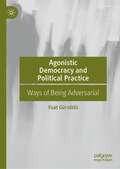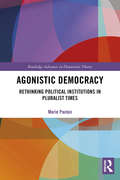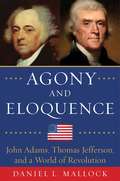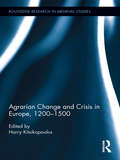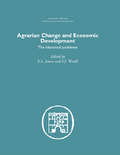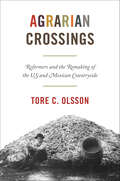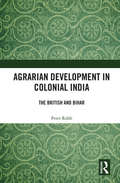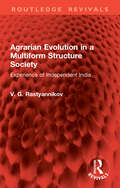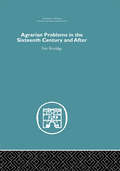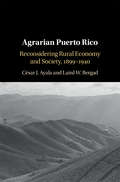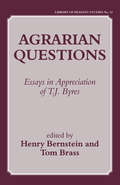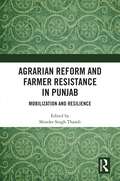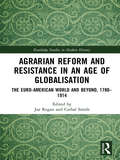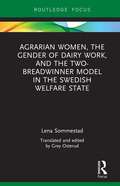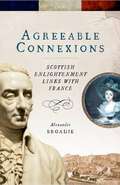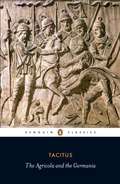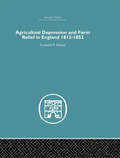- Table View
- List View
Agnès Sorel: Mistress of Beauty
by HRH Michael of KentFrom HRH Princess Michael of Kent, bestselling author of The Queen of Four Kingdoms, comes the extraordinary second volume in the Anjou trilogy.Yolande, the Queen of Four Kingdoms is dead. Agnès Sorel, beautiful, innocent, twenty years old, had arrived a year earlier with the court of Yolande's son, René D'Anjou, and remained with his mother at her request, knowing how much the King of France, her dissolute son-in-law Charles VII, would need wise guidance. As a trusted confidant of Yolande, Agnès captivates everyone she meets, and in her role as a demoiselle to René's wife, Isabelle of Lorraine, Agnès finds herself firmly ensconced in the royal court. Soon though, whispers at court regarding Charles's burgeoning feelings for her begin to grow, and despite her best efforts to resist, Agnès is alarmed to discover that she too is in love.Plagued by guilt but unable to deny her feelings for the King, Agnès is forced to choose between her love for Charles, and her duty to herself . . . Praise for The Queen of Four Kingdoms: 'Meticulously researched and powerfully evoked.' Philippa Gregory 'Takes the reader to the heart of this glamorous, dangerous world, and holds them spellbound. I loved it.' Julian Fellowes 'Riveting . . . spellbinding.' Mail on Sunday'A page-turning blend of epic battles, betrayal, seduction and heroism.' Hello
Agnès Sorel: Mistress of Beauty
by HRH Princess of KentFrom HRH Princess Michael of Kent, bestselling author of The Queen of Four Kingdoms, comes the extraordinary second volume in the Anjou trilogy.Yolande, the Queen of Four Kingdoms is dead. Agnès Sorel, beautiful, innocent, twenty years old, had arrived a year earlier with the court of Yolande's son, René D'Anjou, and remained with his mother at her request, knowing how much the King of France, her dissolute son-in-law Charles VII, would need wise guidance. As a trusted confidant of Yolande, Agnès captivates everyone she meets, and in her role as a demoiselle to René's wife, Isabelle of Lorraine, Agnès finds herself firmly ensconced in the royal court. Soon though, whispers at court regarding Charles's burgeoning feelings for her begin to grow, and despite her best efforts to resist, Agnès is alarmed to discover that she too is in love.Plagued by guilt but unable to deny her feelings for the King, Agnès is forced to choose between her love for Charles, and her duty to herself . . . Praise for The Queen of Four Kingdoms: 'Meticulously researched and powerfully evoked.' Philippa Gregory 'Takes the reader to the heart of this glamorous, dangerous world, and holds them spellbound. I loved it.' Julian Fellowes 'Riveting . . . spellbinding.' Mail on Sunday'A page-turning blend of epic battles, betrayal, seduction and heroism.' Hello
Agoge: Rise of a Renegade
by Alejandro LeónIn ancient Greece, the Spartans, who belonged to the city-state Sparta, lived in a different way than the rest of the cities that formed the Greek State. Spartans were extreme: their moto was freedom or death, and they were willing to do anything, literally, anything to keep living free. Robin, a baby left on his luck in the middle of a forest from the very day he was born, was cruelly discarded by the Spartans because of a cataract in his right eye, is rescued and raised by one of the villagers from Helos, a neighbor city. His parents, not wanting to lie the child, on an early age tell him the truth about the way the found him in the forest. Then, little Robin, feeling deeply rejected, swore to himself not to rest until he was able to compensate his inborn defect of his cataract and become the very best warrior in Greece. With this idea on his mind, he puts all his energies into training to be stronger than all the Spartans. So, he created his very own custom training which, according to him, would be harder than the agoge, the spartan training. The years pass and Robin will find himself in many encounters with Spartans in many of his expeditions inside the forest. But soon, his services will be required for a different end: war. A Persian invasion is coming and Sparta summons all the nearby cities to a recruitment process to reinforce its army and avoid the fall of Laconia. Robin will then have the opportunity to show his fierceness and skills in the battle field, the opportunity he prepared his whole life for.
Agonistic Democracy and Political Practice: Ways of Being Adversarial
by Fuat GürsözlüThis book explores the implications of agonistic democratic theory for political practice. Fuat Gürsözlü argues that at a time when political parties exacerbate political division, political protesters are characterized as looters and terrorists, and extreme partisanship and authoritarian tendencies are on the rise, the agonistic approach offers a much-needed rethinking of political practice to critically understand challenges to democracy and envision more democratic, inclusive, and peaceful alternatives. Inspired by Chantal Mouffe’s agonistic theory and drawing on insights of other prominent agonistic scholars, Gürsözlü offers a distinctive approach that develops the connections between the agonistic approach and political practice. His main claim is that approaching democratic politics from an agonistic perspective changes the way we understand the nature of democratic society, the place of political protest in democracy, the nature of adversarial engagement, and the democratic function of political parties. The book also advances an account of agonistic peace that is best fitted to the pluralistic and inherently conflictual nature of democratic societies. This book should be of interest to anyone working in the field of contemporary political theory, political philosophy, peace studies, and philosophy of peace.
Agonistic Democracy: Rethinking Political Institutions in Pluralist Times (Routledge Advances in Democratic Theory)
by Marie PaxtonAgonistic Democracy explores how theoretical concepts from agonistic democracy can inform institutional design in order to mediate conflict in multicultural, pluralist societies. Drawing on the work of Foucault, Nietzsche, Schmitt, and Arendt, Marie Paxton outlines the importance of their themes of public contestation, contingency and necessary interdependency for contemporary agonistic thinkers. Paxton delineates three distinct approaches to agonistic democracy: David Owen’s perfectionist agonism, Mouffe’s adversarial agonism, and William Connolly and James Tully’s inclusive agonism. Paxton demonstrates how each is fundamental to enabling citizens to cultivate better virtues for themselves and society (Owen), motivating democratic engagement (Mouffe) and enhancing relations of respect and understanding between conflicting citizens (Connolly and Tully). Situated within the context of a deeply polarised post-Trump America and post-Brexit Britain, this book reveals the need to rethink our approach to conflict mediation through democratic institutions. Pulling together insights from experimental research with deliberative democratic innovations, Paxton explores how agonistic theory might be institutionalised further. Through discussing ways in which agonistic institutions might be developed to render democracy more virtuous, more engaging, and more inclusive, Agonistic Democracy provides a unique resource for students of contemporary political theory.
Agonistic Memory and the Legacy of 20th Century Wars in Europe (Palgrave Macmillan Memory Studies)
by Stefan Berger Wulf KansteinerThis book discusses the merits of the theory of agonistic memory in relation to the memory of war. After explaining the theory in detail it provides two case studies, one on war museums in contemporary Europe and one on mass graves exhumations, which both focus on analyzing to what extent these memory sites produce different regimes of memory. Furthermore, the book provides insights into the making of an agonistic exhibition at the Ruhr Museum in Essen, Germany. It also analyses audience reaction to a theatre play scripted and performed by the Spanish theatre company Micomicion that was supposed to put agonism on stage. There is also an analysis of a Massive Open Online Course (MOOC) designed and delivered on the theory of agonistic memory and its impact on the memory of war. Finally, the book provides a personal review of the history, problems and accomplishments of the theory of agonistic memory by the two editors of the volume.
Agony Hill: A Mystery (A Bethany, Vermont Mystery #1)
by Sarah Stewart TaylorSet in rural Vermont in the volatile 1960s, Agony Hill is the first novel in a new historical series full of vivid New England atmosphere and the deeply drawn characters that are Sarah Stewart Taylor's trademark.In the hot summer of 1965, Bostonian Franklin Warren arrives in Bethany, Vermont, to take a position as a detective with the state police. Warren's new home is on the verge of monumental change; the interstates under construction will bring new people, new opportunities, and new problems to Vermont, and the Cold War and protests against the war in Vietnam have finally reached the dirt roads and rolling pastures of Bethany. Warren has barely unpacked when he's called up to a remote farm on Agony Hill. Former New Yorker and Back-to-the-Lander Hugh Weber seems to have set fire to his barn and himself, with the door barred from the inside, but things aren’t adding up for Warren. The people of Bethany—from Weber’s enigmatic wife to Warren's neighbor, widow and amateur detective Alice Bellows — clearly have secrets they’d like to keep, but Warren can’t tell if the truth about Weber’s death is one of them. As he gets to know his new home and grapples with the tragedy that brought him there, Warren is drawn to the people and traditions of small town Vermont, even as he finds darkness amidst the beauty.
Agony and Eloquence: John Adams, Thomas Jefferson, and a World of Revolution
by Daniel Mallock<P>The drama of John Adams and Thomas Jefferson is the foundational story of America--courage, loyalty, hope, fanaticism, greatness, failure, forgiveness, love. <P> Agony and Eloquence is the story of the greatest friendship in American history and the revolutionary times in which it was made, ruined, and finally renewed. <P> In the wake of Washington’s retirement, longtime friends Thomas Jefferson and John Adams came to represent the opposing political forces struggling to shape America’s future. Adams’s victory in the presidential election of 1796 brought Jefferson into his administration--but as an unlikely and deeply conflicted vice president. <P>The bloody Republican revolution in France finally brought their political differences to a bitter pitch. In Mallock’s take on this fascinating period, French foreign policy and revolutionary developments--from the fall of the Bastille to the fall of the Jacobins and the rise of Napoleon--form a disturbing and illuminating counterpoint to events, controversies, individuals, and relationships in Philadelphia and Washington. <P>Many important and fascinating people appear in the book, including Thomas Paine, Camille Desmoulins, Dr. Benjamin Rush, Tobias Lear, Talleyrand, Robespierre, Danton, Saint-Just, Abigail Adams, Lafayette, James Madison, John Quincy Adams, Dr. Joseph Priestley, Samuel Adams, Philip Mazzei, John Marshall, Alexander Hamilton, and Edward Coles. They are brought to life by Mallock’s insightful analysis and clear and lively writing. <P>Agony and Eloquence is a thoroughly researched and tautly written modern history. When the most important thing is at stake, almost anything can be justified. <P><b>A New York Times Bestseller</b>
Agrarian Change and Crisis in Europe, 1200-1500 (Routledge Research in Medieval Studies)
by Harry KitsikopoulosAgrarian Change and Crisis in Europe, 1200-1500 addresses one of the classic subjects on economic history: the process of aggregate economic growth and the crisis that engulfed the European continent during the late Middle Ages. This was not an ordinary crisis. During the period 1200-1500, Europe witnessed endemic episodes of famine and a wave of plague epidemics that amounted to one of its worst health crises, rivaled only by the Justinian plague in the sixth century. These challenges called into question the production of goods and services and the distribution of wealth, opening the possibility of fundamental systemic change. This book offers an empirical synthesis on a host of economic, demographic, and technological developments which characterized the period 1200-1500. It covers virtually the entire continent and places equal emphasis both on providing a solid factual framework and comparing and contrasting various theoretical interpretations. The broad geographical and conceptual scope of the book renders it indispensable not only for undergraduate students who take courses relating to the economic and social life of the Middle Ages but also to more advanced scholars who often specialize in only one country or region.
Agrarian Change and Economic Development: The Historical Problems
by E. L. Jones S. J. WoolfAgrarian Change and Economic Development is a landmark volume that examines the historical experience of the relationship between agrarian change and economic development. Because agriculture was until recently man's dominant occupation, scholars have traditionally drawn little attention to its immense historical importance. The essays in this book redress this balance, and illustrate the significance of the western world's escape from an overwhelmingly agrarian condition. It is therefore an ideal work for encouraging those concerned with current problems to perceive agricultural development as professional historians see it, and to question the oversimplified historical analogies commonly employed in development economics. Presenting historical examples of change within particular agricultural systems, and discussing their implications for national economic development, both social scientists and planners less concerned with historical revision will have equal reason to welcome these case studies of the long-run interaction of agrarian change and economic activity. This classic book was first published in 1969.
Agrarian Crossings: Reformers and the Remaking of the US and Mexican Countryside (America in the World)
by Tore C. OlssonIn the 1930s and 1940s, rural reformers in the United States and Mexico waged unprecedented campaigns to remake their countrysides in the name of agrarian justice and agricultural productivity. Agrarian Crossings tells the story of how these campaigns were conducted in dialogue with one another as reformers in each nation came to exchange models, plans, and strategies with their equivalents across the border.Dismantling the artificial boundaries that can divide American and Latin American history, Tore Olsson shows how the agrarian histories of both regions share far more than we realize. He traces the connections between the US South and the plantation zones of Mexico, places that suffered parallel problems of environmental decline, rural poverty, and gross inequities in land tenure. Bringing this tumultuous era vividly to life, he describes how Roosevelt’s New Deal drew on Mexican revolutionary agrarianism to shape its program for the rural South. Olsson also looks at how the US South served as the domestic laboratory for the Rockefeller Foundation’s “green revolution” in Mexico—which would become the most important Third World development campaign of the twentieth century—and how the Mexican government attempted to replicate the hydraulic development of the Tennessee Valley Authority after World War II.Rather than a comparative history, Agrarian Crossings is an innovative history of comparisons and the ways they affected policy, moved people, and reshaped the landscape.
Agrarian Development in Colonial India: The British and Bihar
by Peter RobbThis book looks at agriculture, development, poverty and British rule in India, especially in the Patna Division in Bihar between c.1870–1920. It traces the economic influence of British policies and maps the impact of legal, administrative and scientific interventions to rural conditions and norms in the state. The book discusses British theories and policies of ‘improvement’, comparing them with Bihar’s agricultural practice and socio-economic conditions to draw conclusions about rural impoverishment. Following on from his earlier book, Ancient Rights and Future Comfort on the Bengal Tenancy Act of 1885, the author also presents case studies on famines, debts, canal and village irrigation, flood-protection and the cultivation and production of indigo, opium and sugar. He analyses extensive archival material to reflect on property law, scientific interventions, cropping patterns, trade and intermediaries. He examines the economic role of governments, Eurocentric development theories and the complex impact of development policy on agriculture and society in Bihar. The book will be of interest to academics and students of colonial history, modern Indian history, agrarian studies, economic history, sociology, and development studies. It will also be useful to development practitioners and researchers working on the history of agrarian conditions and public policy.
Agrarian Evolution in a Multiform Structure Society: Experience of Independent India (Routledge Revivals)
by V. G. RastyannikovIndia in the 1950s and 1960s, with its diversity of economic structures and different levels of regional development, offers a unique opportunity to explore a wide range of agrarian evolution within a multiform society. Basing his study on an extensive survey of the existing literature as well as on fieldwork conducted in India, the author analyses in his book Agrarian Evolution in a Multiform Structure Society (first published in English in 1981) the roots of the Indian society and suggests future directions. He argues that India, like many Asian countries, exhibits tendencies peculiar to an economy evolving on the basis of dependent capitalist development.The author goes on to show how the state, in seeking to ease the teething problems of development, has assumed a decisive role, expressed in terms of the nationalisation of certain sectors of private exploitative property, and in the supersession of private interests by public ones. The historically inevitable progress of Indian society is therefore a paradoxical one: because its economy exists on the periphery of its system-moulding structure—world capitalism—it has special problems reconciled only by state intervention, this in turn makes the development of a capitalist society impossible. The result is a unique study of a society which has assumed increasing importance in world affairs.
Agrarian Movements in India: Studies on 20th Century Bihar
by Arvind N. DasFirst published in 1982. Routledge is an imprint of Taylor & Francis, an informa company.
Agrarian Problems in the Sixteenth Century and After
by Eric KerridgePresenting a full and precise description of all legal ties between landlord and tenant in early modern England, Agrarian Problems in the Sixteenth Century and After re-examines one of the key issues in English agrarian history - the question of the legal security of the copyholder. Comparing historical records and literary evidence, Agrarian Problems in the Sixteenth Century and After reprints much of the important 1969 edition of the book, and asserts that: * customary tenants enjoyed legal security in and before the sixteenth century * enclosures proceeded legally, without oppression, and in much the same form (whether ratified in parliament or not) throughout the whole period * depopulation was less extensive than sometimes supposed and that such depopulation as there was often proved economically profitable and not without social benefit. When first published in 1969, this fascinating book represented a unique viewpoint that affected, and in some cases reversed, much accepted opinion. As a landmark work in a highly important area of English agrarian history, it still has considerable impact today.
Agrarian Puerto Rico: Reconsidering Rural Economy and Society, 1899–1940
by Laird W. Bergad César J. AyalaFundamental tenets of colonial historiography are challenged by showing that US capital investment into this colony did not lead to the disappearance of the small farmer. Contrary to well-established narratives, quantitative data show that the increasing integration of rural producers within the US market led to differential outcomes, depending on pre-existing land tenure structures, capital requirements to initiate production, and demographics. These new data suggest that the colonial economy was not polarized into landless Puerto Rican rural workers on one side and corporate US capitalists on the other. The persistence of Puerto Rican small farmers in some regions and the expansion of local property ownership and production disprove this socioeconomic model. Other aspects of extant Puerto Rican historiography are confronted in order to make room for thorough analyses and new conclusions on the economy of colonial Puerto Rico during the early twentieth century.
Agrarian Questions: Essays in Appreciation of T. J. Byres
by Tom Brass Henry BernsteinThis collection celebrates T.J. Byres' seminal contributions to the political economy of the agrarian question. Uniting the various themes is the demonstration of the continuing relevance of a critical, historical and comparative materialist analysis of agrarian question.
Agrarian Reform and Farmer Resistance in Punjab: Mobilization and Resilience
by Shinder Singh ThandiThis book examines the different dimensions of farmer agitations in Punjab, India. It situates the 2020–2021 farmer resistance movement within the wider context of India’s post-independent development trajectory and provides a thorough analysis of various aspects of the farmers' movement in India. The volume contextualizes Punjab’s history of farmer resistance, organization and mobilization strategies, the globalization of the movement, ways of both sustaining the movement and building resilience. While providing a critical understanding of the three farm laws introduced in India in 2020, the book looks at how they may impact farm operations and livelihoods in the post-Green Revolution period and evaluates strategies of inclusive mobilization for gathering support and sustaining the movement both within India and abroad, with special focus on the role of the Sikh diaspora. Essays in this volume also discuss the participation of women in the struggle and how their experience has the potential to transform gender relations both at home and in the public sphere. Integrated, comprehensive, and concisely written by well-known experts, this book will be of interest to those involved with Punjab’s social, political, and economic history, and students and researchers of food and agriculture in developing countries, peasant and social movements, Indian federalism and role of diasporas as non-state actors.
Agrarian Reform and Resistance in an Age of Globalisation: The Euro-American World and Beyond, 1780-1914 (Routledge Studies in Modern History)
by Joe Regan Cathal SmithThis book investigates the causes and effects of modernisation in rural regions of Britain and Ireland, continental Europe, the Americas, and Australasia between 1780 and 1914. In this period, the transformation of the world economy associated with the Industrial Revolution fuelled dramatic changes in the international countryside, as landowning elites, agricultural workers, and states adapted to the consequences of globalisation in a variety of ways. The chapters in this volume illustrate similarities, differences, and connections between the resulting manifestations of agrarian reform and resistance that spread throughout the Euro-American world and beyond during the long nineteenth century.
Agrarian Revolt in a Mexican Village
by Paul FriedrichAgrarian Revolt in a Mexican Village deals with a Taráscan Indian village in southwestern Mexico which, between 1920 and 1926, played a precedent-setting role in agrarian reform. As he describes forty years in the history of this small pueblo, Paul Friedrich raises general questions about local politics and agrarian reform that are basic to our understanding of radical change in peasant societies around the world. Of particular interest is his detailed study of the colorful, violent, and psychologically complex leader, Primo Tapia, whose biography bears on the theoretical issues of the "political middleman" and the relation between individual motivation and socioeconomic change. Friedrich's evidence includes massive interviewing, personal letters, observations as an anthropological participant (e. g. , in fiesta ritual), analysis of the politics and other village culture during 1955-56, comparison with other Taráscan villages, historical and prehistoric background materials, and research in legal and government agrarian archives.
Agrarian Women, the Gender of Dairy Work, and the Two-Breadwinner Model in the Swedish Welfare State
by Lena SommestadIn this volume, Lena Sommestad explores the significance of rural womanhood in the formation of Sweden’s gender-egalitarian welfare state in the early 20th century. Drawing on a rich array of documents, photographs, and interviews with women and men, she analyzes the changing gender division of labor in dairying and illuminates the dynamic processes and debates that shaped industrial workplaces. The book demonstrates the importance of rural women’s gainful labor and organized activism to Sweden’s citizenship-based social policies, which enabled married women to combine childrearing with breadwinning.
Agreeable Connexions: Scottish Enlightenment Links With France
by Alexander BroadieA history of Scotland&’s relationship with France during the Age of Englightenment. Scotland has played an immense role in European high culture through the centuries, and among its cultural links, none have been greater than those with France. This book shows that the connections with France stretch back deep into the Middle Ages, and continue without a break into the eighteenth century, the Age of Enlightenment. In one way or another all the major figures of the Scottish Enlightenment were in close relation to France. Though this book attends to the broad picture of the cultural links binding the two countries, the focus is on certain individuals, especially David Hume, Thomas Reid, Adam Smith, and Adam Ferguson, and certain of their French counterparts such as Montesquieu, Madame de Condorcet, Victor Cousin, and Theodore Jouffroy. Prominent among the areas under discussion are skepticism and common sense, morality and the role of sympathy, and civil society and the question of what constitutes good citizenship. The book should appeal to all with an interest in the broad sweep of Scottish cultural history and more particularly in the country&’s Age of Enlightenment and its links with France.
Agricola and Germania
by TacitusThe Agricola is both a portrait of Julius Agricola - the most famous governor of Roman Britain and Tacitus' well-loved and respected father-in-law - and the first detailed account of Britain that has come down to us. It offers fascinating descriptions of the geography, climate and peoples of the country, and a succinct account of the early stages of the Roman occupation, nearly fatally undermined by Boudicca's revolt in AD 61 but consolidated by campaigns that took Agricola as far as Anglesey and northern Scotland. The warlike German tribes are the focus of Tacitus' attention in the Germania, which, like the Agricola, often compares the behaviour of 'barbarian' peoples favourably with the decadence and corruption of Imperial Rome.
Agricola and the Germania (Penguin Classics)
by Tacitus Harold Mattingly James RivesAgrícola is a tribute to an admired father-in-law, whose greatest accomplishment was his role in the Roman conquest of Britain, and Germania is a description of the peoples who lived beyond the Rhine and the upper Danube, the boundaries of the Roman empire in western Europe. These two short works, dating to AD 97-81 were the first historically oriented compositions of Tacitus, who would go on to become one of the greatest historians of ancient Rome.
Agricultural Depression and Farm Relief in England 1813-1852
by Leonard P. AdamsThis book was first published in 1932.


